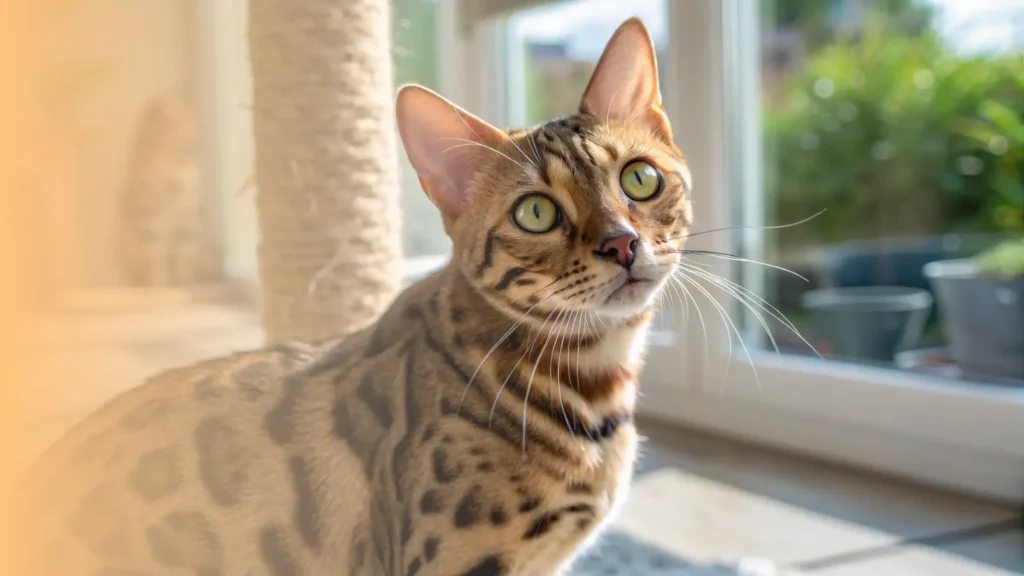That beautifully spotted or marbled cat of yours certainly has an exotic look, doesn’t it?
If you’re wondering whether their striking appearance means they have purebred Bengal ancestry or perhaps a mix of something else, looking closely at their physical features can offer some valuable clues.
While a pedigree is the only sure way to know, let’s explore some common physical signs that might suggest your cat has mixed heritage.
Is Your Cat’s Coat Telling a Mixed Tale?
A Bengal’s coat is one of its most famous features, so differences here can be quite telling. Purebred Bengals have very specific patterns and textures that might not be fully present in a mix.
1. Spots That Aren’t Quite Rosettes
Purebred Bengals are prized for their “rosettes” which are two-toned spots, like little doughnuts or paw-prints, with a darker outline and a lighter center.
If your cat’s spots are mostly solid, single-toned, or look a bit muddled and indistinct without that clear two-tone effect, it could point towards a mixed background.
The overall pattern should ideally have a random or horizontal flow, not just scattered dots.
2. A Marbled Pattern That Looks More Classic Tabby
Bengals can also have a marbled pattern, but it’s a unique, flowing, often horizontal design.
If your cat’s marbled pattern has a very circular “bull’s-eye” look, which is typical of a classic tabby in many other domestic cats, this is a deviation from the Bengal standard.
Poor contrast between the markings and the background color in a marbled pattern can also be an indicator.
3. Vertical Stripes Instead of Random Spots
Take a look at how the spots or markings are arranged on your cat’s body. In Bengals, spots should be random or flow horizontally.
If the spots tend to run together vertically, forming stripes much like a mackerel tabby pattern, this is different from what we’d expect in a purebred Bengal.
4. A Belly Without Spots or Patterns
This is a key detail. Purebred Bengals, whether spotted or marbled, must have a spotted or patterned belly. If your cat’s tummy is plain or has very few markings, it’s a significant sign they might be a mix.
5. A Coat That Lacks Softness or Glitter
A purebred Bengal’s coat is usually short, dense, and feels incredibly soft and silky, almost like a wild animal’s pelt.
Many Bengals also have a special trait called “glitter” which is an iridescent sheen that makes their coat sparkle as if dusted with gold or silver.
If your cat’s coat feels coarser, isn’t very dense, or shows no signs of this glitter, it might suggest some non-Bengal genes.
6. Significant White Patches
While Bengals have lighter fur on their chins, whisker pads, chest, belly, and inner legs, they generally don’t have large, distinct white patches or “lockets” on their main body, like their back or flanks.
If your cat has prominent white spots in these areas, it’s more characteristic of a domestic cat mix.
What About Body Shape and Other Features?
Beyond the coat, other physical traits can offer hints about whether your cat is a purebred Bengal or a mix.
7. Body Type and Head Shape Differences
Purebred Bengals are known for their medium to large, long, very muscular, and athletic build, with substantial boning.
Their head is a broad modified wedge that might look a bit small for their body, with rounded contours and prominent whisker pads.
If your cat has a very short and compact (cobby) body, or is extremely slender and fine-boned like an Oriental breed, or if their head is rounder and more like a typical domestic shorthair without those distinct Bengal features, it could indicate a mixed lineage.
A weak chin also differs from the strong chin expected in Bengals.
8. Ears, Eyes, and Tail That Don’t Quite Match
Bengal ears are typically medium to small, relatively short with a wide base and rounded tips, set wide apart.
Their eyes are large, oval (almost round), and also set wide apart, giving them an expressive “nocturnal look.” Their tail is generally medium in length, thick, and tapers to a rounded tip.
If your cat has very large, pointed ears set high on the head, or small, distinctly almond-shaped eyes set close together, or a thin, whip-like, overly long tail, these features are less typical of a purebred Bengal and might suggest a mix.
Final Thoughts
Observing these physical traits can give you a much better idea if your wonderfully unique cat has some Bengal mix in their family tree.
Remember, every cat is special regardless of their ancestry, but understanding these signs can help satisfy your curiosity about their distinctive looks.







